Related Research Articles

Manhattan is the most densely populated and geographically smallest of the five boroughs of New York City. The borough is also coextensive with New York County, one of the original counties of the U.S. state of New York. Located near the southern tip of New York State, Manhattan is based in the Eastern Time Zone and constitutes both the geographical and demographic center of the Northeast megalopolis and the urban core of the New York metropolitan area, the largest metropolitan area in the world by urban landmass. Over 58 million people live within 250 miles of Manhattan, which serves as New York City’s economic and administrative center, cultural identifier, and the city’s historical birthplace. Residents of the outer boroughs of New York City often refer to Manhattan as "the city". Manhattan has been described as the cultural, financial, media, and entertainment capital of the world, and hosts the United Nations headquarters. Manhattan also serves as the headquarters of the global art market, with numerous art galleries and auction houses collectively hosting half of the world’s art auctions.
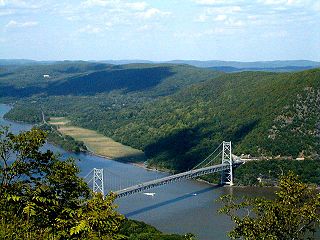
The Hudson River is a 315-mile (507 km) river that flows from north to south primarily through eastern New York. It originates in the Adirondack Mountains of Upstate New York and flows southward through the Hudson Valley to the New York Harbor between New York City and Jersey City, eventually draining into the Atlantic Ocean at Lower New York Bay. The river serves as a physical boundary between the states of New Jersey and New York at its southern end. Farther north, it marks local boundaries between several New York counties. The lower half of the river is a tidal estuary, deeper than the body of water into which it flows, occupying the Hudson Fjord, an inlet which formed during the most recent period of North American glaciation, estimated at 26,000 to 13,300 years ago. Even as far north as the city of Troy, the flow of the river changes direction with the tides.

Hudson County is the smallest and most densely populated county in the U.S. state of New Jersey. It lies west of the lower Hudson River, which was named for Henry Hudson, the sea captain who explored the area in 1609. Part of New Jersey's Gateway Region in the New York metropolitan area, the county seat is Jersey City, which is the county's largest city in terms of both population and area, with a 2020 population of 292,449, and which covered 21.08 square miles (54.6 km2).

Hoboken is a city in Hudson County in the U.S. state of New Jersey. Hoboken is part of the New York metropolitan area and is the site of Hoboken Terminal, a major transportation hub for the tri-state region. As of the 2020 United States census, the city's population was 60,419, an increase of 10,414 (+20.8%) from the 2010 census count of 50,005, which in turn reflected an increase of 11,428 (+29.6%) from the 38,577 counted in the 2000 census. The Census Bureau's Population Estimates Program calculated that the city's population was 58,690 in 2021, ranking the city as the 668th-most-populous in the country. With more than 42,400 inhabitants per square mile (16,400/km2) in data from the 2010 census, Hoboken was ranked as the third-most densely populated municipality in the United States among cities with a population above 50,000. In the 2020 census, the city's population density climbed to more than 48,300 inhabitants per square mile (18,600/km2) of land, ranked fourth in the county behind Guttenberg, Union City and West New York.

The Holland Tunnel is a vehicular tunnel under the Hudson River that connects Hudson Square and Lower Manhattan in New York City in the east to Jersey City and New Jersey in the west. The tunnel is operated by the Port Authority of New York and New Jersey and carries Interstate 78. The New Jersey side of the tunnel is the eastern terminus of NJ Route 139. The Holland Tunnel is one of three vehicular crossings between Manhattan and New Jersey; the two others are the Lincoln Tunnel and George Washington Bridge.

Pennsylvania Station, also known as New York Penn Station or simply Penn Station, is the main intercity railroad station in New York City and the busiest transportation facility in the Western Hemisphere, serving more than 600,000 passengers per weekday as of 2019. It is located in Midtown Manhattan, beneath Madison Square Garden in the block bounded by Seventh and Eighth Avenues and 31st and 33rd Streets, and in the James A. Farley Building, with additional exits to nearby streets. It is close to Herald Square, the Empire State Building, Koreatown, and Macy's Herald Square.

North River is an alternative name for the southernmost portion of the Hudson River in the vicinity of New York City and northeastern New Jersey in the United States. The entire watercourse was known as the North River by the Dutch in the early seventeenth century; the term fell out of general use for most of the river's 300+ mile course during the early 1900s. The name remains in limited use among local mariners and others and on some nautical charts and maps. The term is also used for infrastructure on and under the river, such as the North River piers, North River Tunnels, and the North River Wastewater Treatment Plant.
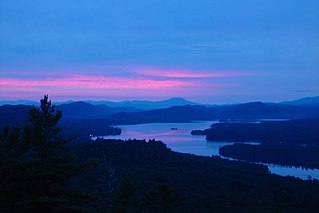
Upstate New York is a geographic region consisting of the area of New York State that lies north and northwest of the New York City metropolitan area. Although the precise boundary is debated, Upstate New York excludes New York City and Long Island, and most definitions of the region also exclude all or part of Westchester and Rockland counties, which are typically included in Downstate New York. Major cities across Upstate New York from east to west include Albany, Utica, Binghamton, Syracuse, Rochester, and Buffalo.

Consolidated Edison, Inc., commonly known as Con Edison or ConEd, is one of the largest investor-owned energy companies in the United States, with approximately $12 billion in annual revenues as of 2017, and over $62 billion in assets. The company provides a wide range of energy-related products and services to its customers through its subsidiaries:

Fort Tryon Park is a public park located in the Hudson Heights and Inwood neighborhoods of the borough of Manhattan in New York City. The 67-acre (27 ha) park is situated on a ridge in Upper Manhattan, close to the Hudson River to the west. It extends mostly from 192nd Street in the south to Riverside Drive in the north, and from Broadway in the east to the Henry Hudson Parkway in the west. The main entrance to the park is at Margaret Corbin Circle, at the intersection of Fort Washington Avenue and Cabrini Boulevard.

Indian Point Energy Center (I.P.E.C.) is a three-unit nuclear power plant station located in Buchanan, just south of Peekskill, in Westchester County, New York. It sits on the east bank of the Hudson River, about 36 miles (58 km) north of Midtown Manhattan. The facility has permanently ceased power operations as of April 30, 2021. Before its closure, the station's two operating reactors generated about 2,000 megawatts (MWe) of electrical power, about 25% of New York City's usage. The station is owned by Holtec International, and consists of three permanently deactivated reactors, Indian Point Units 1, 2, and 3. Units 2 and 3 were Westinghouse pressurized water reactors. Entergy purchased Unit 3 from the New York Power Authority in 2000 and Units 1 and 2 from Consolidated Edison in 2001.
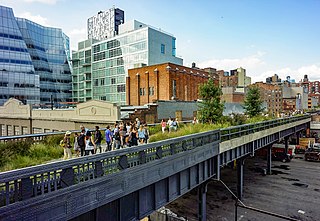
The High Line is a 1.45-mile-long (2.33 km) elevated linear park, greenway and rail trail created on a former New York Central Railroad spur on the west side of Manhattan in New York City. The High Line's design is a collaboration between James Corner Field Operations, Diller Scofidio + Renfro, and Piet Oudolf. The abandoned spur has been redesigned as a "living system" drawing from multiple disciplines which include landscape architecture, urban design, and ecology. The High Line was inspired by the 4.7 km (2.9 mi) long Coulée verte, a similar project in Paris completed in 1993.

American Dream is a large retail and entertainment complex in the Meadowlands Sports Complex in East Rutherford, New Jersey, United States. The first and second of four opening stages occurred on October 25, 2019, and on December 5, 2019. The remaining opening stages occurred on October 1, 2020, and thereafter.

Hudson River Park is a waterfront park on the North River that extends from 59th Street south to Battery Park in the New York City borough of Manhattan. The park, a component of the Manhattan Waterfront Greenway, stretches 4.5 miles (7.2 km) and comprises 550 acres (220 ha), making it the second-largest park in Manhattan after the 843-acre (341 ha) Central Park.

New York, often called New York state to distinguish it from its largest city, New York City, is a state in the Northeastern United States. With 20.2 million people, it is the fourth-most populous state in the United States as of 2021, approximately 44% of the state's population lives in New York City, including 25% in the boroughs of Brooklyn and Queens and 15% on Long Island, the most populous island in the United States. With a total area of 54,556 square miles (141,300 km2), New York is the 27th-largest U.S. state by area. The state is bordered by New Jersey and Pennsylvania to the south, and Connecticut, Massachusetts, and Vermont to the east; it has a maritime border with Rhode Island, east of Long Island, and an international border with the Canadian provinces of Quebec to the north and Ontario to the northwest.
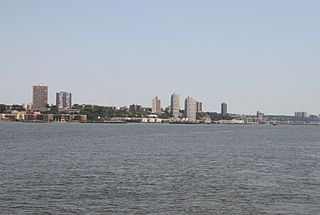
North Hudson is the area in the northern part of Hudson County, New Jersey, situated on the west bank of the Hudson River, mostly atop the Hudson Palisades. It comprises Weehawken, Union City, West New York, Guttenberg, and North Bergen.

The Park Avenue main line, which consists of the Park Avenue Tunnel and the Park Avenue Viaduct, is a railroad line in the New York City borough of Manhattan, running entirely along Park Avenue. The line carries four tracks of the Metro-North Railroad as a tunnel from Grand Central Terminal at 42nd Street to a portal at 97th Street, where it rises to a viaduct north of 99th Street and continues over the Harlem River into the Bronx over the Park Avenue Bridge. During rush hours, Metro-North uses three of the four tracks in the peak direction.
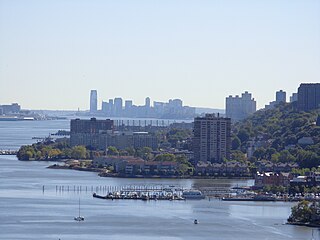
The Hudson Waterfront is an urban area of northeastern New Jersey along the lower reaches of the Hudson River, the Upper New York Bay and the Kill van Kull. Though the term can specifically mean the shoreline, it is often used to mean the contiguous urban area between the Bayonne Bridge and the George Washington Bridge that is approximately 19 miles (31 km) long. Historically, the region has been known as Bergen Neck, the lower peninsula, and Bergen Hill, lower Hudson Palisades. It has sometimes been called the Gold Coast.

Between 1947 and 1977, General Electric polluted the Hudson River by discharging polychlorinated biphenyls (PCBs) causing a range of harmful effects to wildlife and people who eat fish from the river. Other kinds of pollution, including mercury contamination and cities discharging untreated sewage, have also caused problems in the river.

Little Island at Pier 55 is an artificial island park in the Hudson River west of Manhattan in New York City, adjoining Hudson River Park. Designed by Heatherwick Studio, it is near the intersection of West Street and 13th Street in the Meatpacking District and Chelsea neighborhoods of Manhattan. It is located slightly west of the Manhattan shoreline atop Hudson River Pier 55, connected to Hudson River Park in Manhattan by footbridges at 13th and 14th Streets.
References
- ↑ Archibold, Randal C. (April 9, 2003). "Before Power Plants, Glory Days at Indian Point". The New York Times . Archived from the original on June 18, 2017. Retrieved August 21, 2018.
- ↑ Robbins, Dan (April 5, 2016). "The (North Of) Manhattan Project: Indian Point's Amusement Park Past". Westchester Magazine . Archived from the original on March 8, 2023. Retrieved August 21, 2018.
- ↑ Hodara, Susan (June 27, 2018). "Buchanan, N.Y.: A Waterfront Village Braces for Big Changes". The New York Times . Archived from the original on August 22, 2020. Retrieved March 8, 2023.